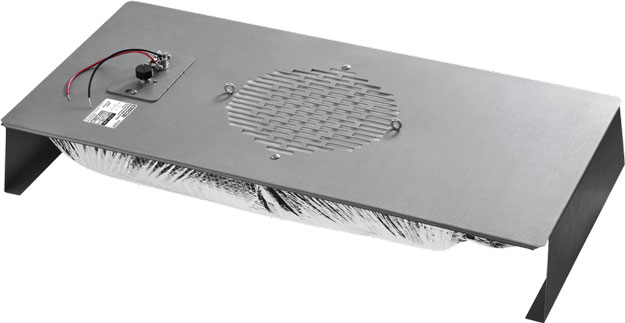Paging speakers, also known as PA speakers, are most often used for one of three purposes: voice broadcasts, emergency alerts, and background music.
But there’s another use for paging speakers that can be vital in certain situations: sound masking.
Sound masking speakers are paging speakers that play ambient background sound to camouflage distracting sounds, in particular human voices. They don’t reduce sound levels — in fact, they add sound — but they make it harder for people to perceive distracting sounds. They’re available from paging speaker manufacturers like Bogen.
In this blog, we explain how sound masking speakers work, then describe the two primary scenarios when sound masking speakers are particularly advantageous:
Let’s get into it!

How Do Sound Masking Speakers Work?
Here’s a bit of science. Audio camouflage works in pretty much the same way as the more familiar visual camouflage. Let’s use a soldier as an example.
A soldier’s camouflage works by making them more difficult to perceive by the human eye. It does this by being a similar color to the surroundings, having a pattern that mimics shapes in the environment, and by disrupting the outline of the soldier’s body.
A sound masking speaker works in a similar fashion: it’s audio camouflage.
Basically, it plays ambient sound similar to white noise, but which is tuned for the same part of the audio spectrum that the human voice uses, like wearing green and brown camouflage that’s the same color as the surrounding vegetation. The sound is random, so the ear doesn’t perceive an outline to it, disrupting the “outline” of human voices and other sounds.
By elevating sound levels across all the relevant parts of the audio spectrum, the sound reduces the ear’s ability to pick out individual noises that would otherwise catch your brain’s attention.
Sound masking speakers are paging speakers that are specially designed to play this kind of audio camouflage more effectively than a normal paging speaker.
You might be wondering if sound masking speakers work the same way as Active Noise Cancellation (ANC) with headsets. The process is similar, but slightly different. With ANC, microphones on the headset pick up surrounding sound, then the headset produces counter-sound that, basically, cancels out the sound.
If you’d like to know more about Active Noise Cancellation, check out our blog, “Active Noise Cancellation vs Passive Noise Cancellation.”

Using a Sound Masking Speaker to Enhance Privacy
The primary use of a sound masking speaker is to improve privacy, which it does by making speech harder to overhear.
Sound masking speakers can both improve privacy in the location that the speaker is installed in and reduce the amount of comprehensible sound that travels through air handling ducts and spaces.
How they work in a location is simple to understand. They play ambient sound, which masks sound within a given range from the speaker. The goal is to have the ambient sound be loud enough to mask voices without being so loud as to be distracting itself. If you could understand a conversation from 45 feet away without one, you might be able to understand a conversation from only 15 feet with one.
For example, you might install a sound masking speaker in a clinic waiting area. Visitors will be able to speak to the receptionist without worrying about other people hearing their sensitive information.
You can also have multiple speakers working together.
For example, modern open-plan offices tend to have hard walls, ceiling, and floors, which have the effect of making noises and voices sound louder. Installing an array of sound masking speakers can greatly help in open offices. You’ll have to plot out multiple speakers for optimal coverage.
Sound masking speakers are often used to reduce the amount of sound that passes through plenums. In this context, plenums are the air handling spaces like you find above ceiling tiles.
A lot of sound can pass through plenums. It’s not unusual to be able to hear conversations through them, as might have happened in your office space.
The solution is to pipe ambient noise into the plenum. Some sound masking speakers like Bogen NQ-SMS1810-SCG are actually designed with the speaker pointing up. These vertically firing speakers are used specifically for filling plenums with sound masking ambient audio.
This type of sound masking speaker is particularly necessary where sensitive information is being discussed, such as in healthcare situations. You don’t want your private discussions with your doctor being carried through the plenum to the lobby. In some cases, it can help an institution be HIPAA compliant for patient privacy.
If you want to use a sound masking speaker in a plenum, make sure it’s rated for installation in air handling spaces. Look for “UL 2043 Rated,” which refers to an industry standard whose full name tells you everything you need to know: “Standard for Fire Test for Heat and Visible Smoke Release for Discrete Products and Their Accessories Installed in Air-Handling Spaces.”
Privacy isn’t the only use for a sound masking speaker. They’re also used to help improve focus.

Using a Sound Masking Speaker to Create a Productive Atmosphere
Sound masking speakers can improve productivity in workspaces by creating a focus-enhancing atmosphere.
Many workers today listen to white noise (or another “color” of noise like pink noise) on their headphones while they work, because it reduces the amount of ambient distractions that their ears naturally pick up on. Studies show that, for many people, white noise helps improve focus. Why?
Neuroscientists have discovered that the human brain has what they call “novelty detector neurons.” These neurons automatically respond to “novel” stimuli.
In our context, these neurons mean that a worker’s brain automatically pays attention to sounds like voices, which stand out from the ambient background. They’re novel stimuli. On top of which, humans naturally respond to human speech. We’re social creatures, after all.
So, the theory goes, if you increase the ambient background sound level to mask these “novel” sounds, it can help reduce how often a worker’s novelty detector neurons fire, thus helping them to focus. By improving focus, you improve productivity.
The same effect also helps for places where people need to sleep, like in hospital wards. For many people, white noise helps them to relax, because noises are less sharp, less noticeable.
Sound masking speakers are thus useful in an enormous range of locations, including healthcare facilities, business offices, law offices, government offices, and even places like libraries or schools.
Anywhere people need privacy and need to focus.
To finish, two words of caution:
First, Bogen, in their material on sound masking via a Bogen Nyquist IP-based paging system, notes that it can take time for someone to get used to having sound masking speakers playing. The initial exposure can be jarring.
Their solution: gently ramping up the sound levels as the workday progresses and gently ramping down the sound levels it ends. This gives workers time to adjust. Using systems like Nyquist, you can schedule these gradual increases and decreases as part of the paging system’s daily routine.
Second, you never want to play ambient sound at such a decibel level that it can harm hearing. In a previous blog, we covered how headsets protect your hearing, in part by protecting against long-term exposure to elevated sound levels. The same principles discussed in that blog apply to sound masking speakers.

